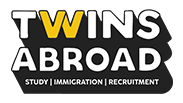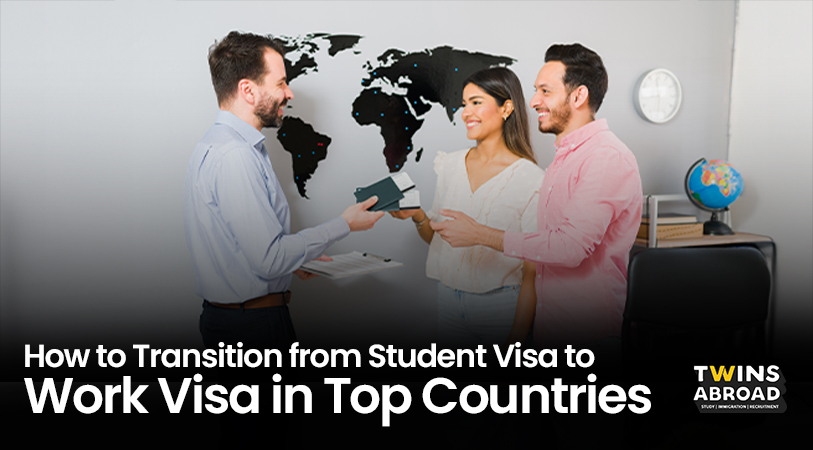How to Transition from Student Visa to Work Visa in Top Countries
For many international students, the ultimate goal of studying abroad is to gain valuable work experience in the host country. Transitioning from a student visa to a work visa is a crucial step in turning this aspiration into a reality. It can be a complex process, requiring thorough understanding of the visa regulations, job market, and country-specific requirements. In this guide, we will explore how international students can navigate the transition from a student visa to a work visa in some of the top study-abroad destinations, including the USA, UK, Canada, Australia, and Germany.
Understanding Work Visa
A work visa is a legal authorization that permits a foreign national to take up employment in a particular country for a specified period. The work visa is distinct from a student visa in that it is intended for individuals who have completed their studies and are looking to enter the workforce.
Key Differences Between a Student Visa and Work Visa
- Purpose: A student visa allows you to study and sometimes work part-time, while a work visa is specifically for employment.
- Duration: Student visas are typically granted for the length of your academic program, whereas work visas may have varying durations based on the type of employment.
- Eligibility: Student visa holders often need to demonstrate that they have the qualifications and job offer required to transition to a work visa.
General Steps to Transition from a Student Visa to a Work Visa
While the specific processes vary by country, the following general steps apply across most nations:
- Secure a Job Offer: In many countries, securing a job offer from an employer is a key requirement for transitioning to a work visa.
- Understand Your Visa Options: Research the different types of work visas available in the country you are in. Each work visa has different eligibility criteria, duration, and application procedures.
- Check for Graduate Programs: Some countries offer work visa pathways specifically designed for recent graduates. These programs often come with certain benefits, such as extended stay periods and relaxed eligibility criteria.
- Submit Your Application: After ensuring that you meet the necessary requirements, submit your application to the immigration authorities.
- Wait for Approval: Once your application is submitted, there may be a waiting period before you receive a response. In some cases, you may be required to attend an interview or provide additional documentation.
- Prepare for Your New Work Life: Once your work visa is approved, it’s time to transition from student life to professional life. This includes finalizing your work contract, securing accommodation, and planning for long-term residency.
Now, let’s dive into the specifics of transitioning from a student visa to a work visa in top countries.
USA: From F-1 Visa to H-1B Visa
The United States remains a top destination for international students, and many students wish to stay and work in the country after graduation. The most common route for transitioning from an F-1 student visa to a work visa is through the H-1B visa.
H-1B Visa: The Pathway to Employment
The H-1B visa is a non-immigrant visa that allows U.S. companies to hire foreign workers in specialty occupations. To qualify for an H-1B visa, you need to:
- Obtain a Job Offer: The first step is securing a job with a U.S. employer who is willing to sponsor you for an H-1B visa. The job must be in a specialty occupation related to your degree.
- Employer Sponsorship: The employer must file a petition with U.S. Citizenship and Immigration Services (USCIS). This includes providing evidence that you meet the qualifications for the job.
- Cap and Lottery System: The H-1B visa is subject to an annual cap, and the application process often involves a lottery system. However, students with a U.S. advanced degree may have a higher chance of selection.
- OPT Program: Many students on an F-1 visa can apply for Optional Practical Training (OPT), which allows them to work in the U.S. for up to 12 months (or 36 months for STEM graduates) while waiting for their H-1B visa to be approved.
Additional Visa Options
If the H-1B visa route doesn’t work out, there are alternative visas such as the L-1 (for intra-company transfers) or O-1 (for individuals with extraordinary skills in their field).
UK: From Tier 4 to Tier 2 (General) Visa
The United Kingdom offers a straightforward pathway for international students to transition from a student visa (Tier 4) to a work visa (Tier 2 General) after graduation.
Tier 2 (General) Visa: Key Steps
- Graduate with a Recognized Degree: Your degree must be from a recognized UK institution.
- Obtain a Job Offer: To transition to a Tier 2 visa, you must first secure a job with a sponsor. The job must meet the minimum salary requirements and be in a graduate-level occupation.
- Sponsorship: The employer must be licensed to sponsor international workers. The employer will provide you with a Certificate of Sponsorship.
- Visa Application: Once you receive the Certificate of Sponsorship, you can apply for a Tier 2 visa. You will need to provide evidence of your job offer, salary, and qualifications.
Canada: From Study Permit to Post-Graduation Work Permit (PGWP)
Canada offers a favorable pathway for students who want to stay and work after graduation through the Post-Graduation Work Permit (PGWP).
PGWP: Work After Graduation
- Complete a Program at a Designated Learning Institution: To qualify for the PGWP, you must have completed a program of study that lasted at least eight months at a recognized Canadian institution.
- Apply Within 180 Days: You must apply for the PGWP within 180 days of receiving your final transcript or official letter confirming the completion of your program.
- Work Full-Time: The PGWP allows you to work full-time in Canada in any field. The duration of the work permit depends on the length of your study program (up to three years).
- Transition to Permanent Residency: After working in Canada for a few years, you may be eligible to apply for permanent residency through programs like the Express Entry system, which is based on factors such as work experience, language skills, and education.
Australia: From Subclass 500 to Subclass 485
Australia’s Subclass 485 Temporary Graduate visa allows international students to stay and work after graduation.
Subclass 485: Two Streams
- Graduate Work Stream: This is for international students who have completed a qualification that relates to an occupation on Australia’s skilled occupation list. The visa is valid for 18 months.
- Post-Study Work Stream: For students who have completed a degree at a higher education level in Australia, the visa is valid for 2-4 years, depending on the level of qualification.
Pathway to Permanent Residency
After gaining work experience in Australia, graduates may be eligible to apply for permanent residency through the Skilled Migration Program, which includes the Skilled Independent Visa (subclass 189).
Germany: From Student Visa to EU Blue Card
Germany provides international students with a streamlined process for transitioning from a student visa to the EU Blue Card, a work permit designed for highly skilled workers.
EU Blue Card: Requirements
- Job Offer: To qualify for an EU Blue Card, you must have a job offer in Germany that matches your qualifications and offers a salary above a specific threshold.
- Educational Qualifications: Your degree should be from a German university or recognized institution, or it should be comparable to a German qualification.
- Application Process: You can apply for the EU Blue Card from within Germany, allowing you to stay and work for up to four years.
Conclusion
The transition from a student visa to a work visa is a significant step in your international career journey. By securing a job offer, understanding visa requirements, and following the necessary application steps, you can successfully make this transition in top study-abroad destinations like the USA, UK, Canada, Australia, and Germany. Take advantage of the resources and programs available in these countries, and set yourself up for long-term professional success.


Leave a Reply